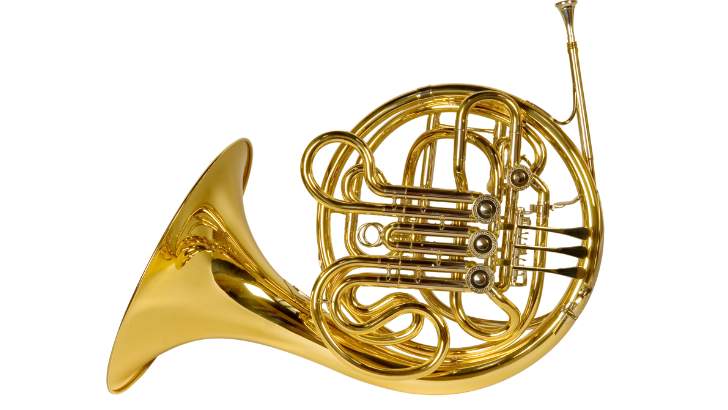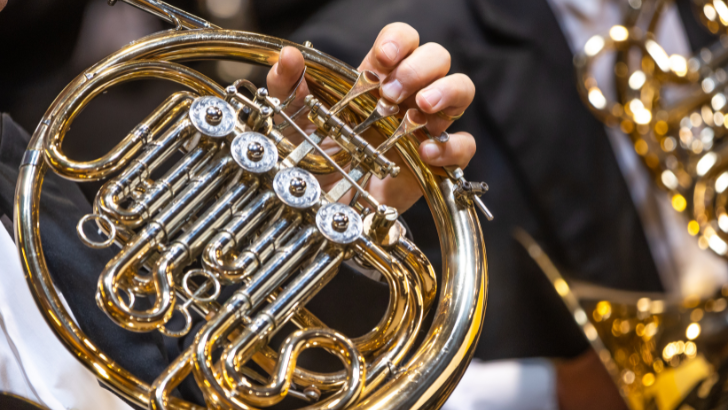
What is a French Horn Instrument?
The French horn is a brass instrument known for its distinctive circular shape and rich, mellow sound. It features a long, coiled tube ending in a flared bell, with valves for changing pitch. Played by blowing air through a mouthpiece, it’s a key part of orchestras and bands.

How Popular is the French Horn?
As can be seen from the Google Trends chart below, the French horn is very popular in most American and European countries. As a prominent instrument in orchestral, broadway and film scores instrument has a wide global popularity.
Source : Google Trends
French Horn Instrument Facts
- Musicians who play the French horn are called hornists.
- A standard French horn weighs about 2 to 4 kg (4.4 to 8.8 lbs), making it a manageable instrument for most players.
- The instrument’s length, if uncoiled, measures about 3.7 meters (12 feet).
- The instrument is classified under the Hornbostel–Sachs system as a valved aerophone. Its classification is due to the way sound is produced by air blown through lips vibrated into a cup-shaped mouthpiece.
- In classical music, the French horn section is crucial in orchestras, chamber music, and as a solo instrument.
- The Vienna horn, a type of French horn, is known for its unique, warm sound and is preferred in some classical music settings.
- The double horn, with two sets of tubing, allows players to switch between different keys more easily, offering greater flexibility.
- Marching French horns, designed for use in marching bands, have a forward-facing bell.
- A professional-level French horn can cost between $4,000 and $10,000, with some custom models reaching even higher prices.
- French horn players can use their hand in the bell to create a muffled effect, known as “hand-stopping.”
- The triple horn, offering even more key options, caters to advanced players seeking a wide range of tones.
- Despite its name, the French horn originated in Germany; the “French” label was applied in England due to France’s reputation for high-quality brass instruments.
What does a French Horn Instrument Sound Like?
The French horn produces a smooth, rich sound that ranges from mellow and warm to bold and heroic. For a closer listen at its captivating tones, watch the video below which showcases the instrument’s diverse musical repertoire.
How to Play the French Horn Instrument
Playing the French horn involves a fascinating interplay of breath, lip tension, and valve manipulation to produce its characteristic sound.
To start, the player vibrates their lips against the mouthpiece, blowing air through a narrow tube that spirals into a large, flared bell. This action sets the air column inside the horn vibrating, creating sound.
The French horn’s unique sound is also shaped by the player’s hand position in the bell. By adjusting their hand placement, hornists can alter the pitch and tone quality, producing a range of sounds from soft, mellow tones to powerful, bright blasts. This technique, known as “hand-stopping,” allows for greater expressive capabilities.
The instrument’s pitch is further controlled by a series of rotary valves. Pressing these valves redirects the air path through additional tubing, changing the length of the air column and, consequently, the pitch. By combining lip tension adjustments with precise valve combinations, the player can access a wide range of notes across several octaves.
Modern French horns typically have three or four valves, with some models equipped with a double or triple horn system. This design offers two or three sets of tubing for different key signatures, enhancing the instrument’s versatility. Players switch between these sets using a thumb-operated valve, enabling them to play more accurately in various musical contexts.
Mastering the French horn requires a blend of technical skill and musical expression. Players must develop a keen ear for pitch and tone quality, along with the physical stamina to manage breath control over extended performances.
French Horn Instrument Description
The French horn consists of several key parts crafted from various materials that contribute to its distinctive sound and appearance. Understanding these components provides insight into the instrument’s functionality and the craftsmanship behind it.
Mouthpiece: The point of interaction for the player, the mouthpiece is typically made of brass or silver. It channels the player’s breath into the instrument and is crucial for tone production. Silver mouthpieces offer a brighter sound, while brass versions tend to produce a warmer tone.
Leadpipe: Extending from the mouthpiece, the leadpipe is the initial tubing through which the air travels. Made of brass, it significantly influences the horn’s overall intonation and response. Some high-end models feature gold or nickel silver leadpipes for added durability and a slightly different tonal color.
Valves and Rotary Valves: French horns utilize rotary valves to change the pitch by directing air through additional tubing. These are commonly made of brass with internal mechanisms of metal alloys for smooth operation. The choice of material affects the instrument’s sound and action; nickel silver valves, for example, offer a brighter tone and added strength.

Valve Casings and Slides: Made from brass, valve casings house the rotary valves, while the slides, also brass, allow the player to adjust the tuning of the horn. Higher-quality horns may use nickel silver for these parts for its corrosion resistance and tonal benefits.
Tubing: The body of the French horn consists of long, coiled brass tubes that end in a wide, flared bell. The tubing’s length and shape are critical for the instrument’s pitch and sound characteristics. The use of yellow brass, gold brass, or nickel silver affects the horn’s tonal qualities, with gold brass producing a richer sound and nickel silver a brighter, more focused tone.
Bell: The bell is the final part of the horn where the sound emerges. It can be made from brass, with variations in material and manufacturing processes (such as hand-hammering) influencing the sound projection and color. Detachable bells are common in professional models, offering portability and the option to change bells for different sound characteristics.
Different Types of French Horn Instrument to Learn
There are several types of French horns available for musicians to learn, each offering its unique set of advantages and challenges. Below is a list of these instruments along with their respective pros and cons:
Single French Horn
- Pros: Lightweight and easier to handle, making it ideal for beginners.
- Cons: Limited range and flexibility compared to other models, which may restrict advanced repertoire.
Double French Horn
- Pros: Offers a wider range and better accuracy in higher registers, preferred by intermediate and advanced players.
- Cons: Heavier and more complex, requiring a longer learning curve.
Triple French Horn
- Pros: Provides the most extensive range and versatility with three sets of tubing for different keys.
- Cons: The complexity and weight make it challenging for beginners, and it’s typically more expensive.
Descant French Horn
- Pros: Designed for high-pitched music, it offers easier playability in the upper register.
- Cons: Less versatile for playing lower ranges, limiting its use to specific musical pieces.
Marching French Horn
- Pros: Projected to carry sound forward, making it ideal for outdoor performances and marching bands.
- Cons: Limited use outside of marching and military bands.
Vienna Horn
- Pros: Known for its warm, rich tone, favored in classical music and orchestral settings.
- Cons: Uses a different valve system (Pumpenvalves) that can be difficult for players used to rotary or piston valves.
Musical Origins of the French Horn
The name “French horn” stems from its early development and use in France, where it gained popularity as a hunting instrument before evolving into a musical instrument in the 17th century.
Despite its significant development in Germany, the English-speaking world adopted the term “French horn” to distinguish it from similar instruments, attributing its refined design and widespread use to French musical culture.
This name has persisted, even though the instrument has undergone substantial evolution far beyond its French origins.
Below is a table detailing the major stages of the instruments development over time:
| Year/Period | Development |
|---|---|
| 17th Century | The natural horn, ancestor of the French horn, is used in hunting and music. |
| Early 18th Century | The addition of crooks to change the horn’s pitch becomes common. |
| Mid-18th Century | Hand-stopping technique is introduced, expanding the horn’s musical range. |
| Late 19th Century | The valve horn is invented, allowing for smoother transitions between notes. |
| Early 20th Century | The double horn emerges, combining F and B♭ sides for greater versatility. |
| Mid-20th to 21st Century | Triple and descant horns are developed, enhancing range and flexibility. |
Famous French Horn Players
The French horn has been graced by many skilled musicians whose contributions have left an indelible mark on the world of music. These players have elevated the instrument’s profile, showcasing its versatility across various musical genres. Here, we highlight five renowned hornists who have significantly impacted the French horn’s legacy.
Dennis Brain
1921–1957, England: Dennis Brain was a virtuoso British horn player renowned for his remarkable technique and musicality. His recordings, particularly of Mozart’s Horn Concertos, are considered definitive, contributing greatly to the modern popularity of the French horn.
Barry Tuckwell
1931–2020, Australia: An Australian horn player, Barry Tuckwell, is noted for his extensive solo career and recordings. His technical prowess and expressive playing made him one of the most recorded hornists in history, earning him international acclaim.
Hermann Baumann
Born 1934, Germany: A standout player from Germany, Hermann Baumann has been praised for his virtuosic skill and deep musical insight. He has significantly contributed to the horn repertoire, including historical works and contemporary compositions.
Radovan Vlatković
Born 1962, Croatia: Radovan Vlatković is celebrated for his exceptional tone and agility on the French horn. As one of the leading horn soloists of his generation, he has won numerous awards and is highly regarded for his teaching and masterclass instruction.
Sarah Willis
Born 1969, England/Germany: Sarah Willis has gained fame not only for her proficiency on the horn with the Berlin Philharmonic but also for her efforts to popularize classical music through television and social media. Her projects, including “Horn Hangouts,” showcase her dedication to music education and the French horn.
Significant French Horn in Classical Music
The French horn is celebrated for its rich, warm sound that adds depth and emotion to orchestral and chamber music.
Here is a look at ten classical compositions that feature the French horn, offering listeners a glimpse into its profound musical capabilities and its unique place in the history of classical music.
- Wolfgang Amadeus Mozart – Horn Concerto No. 4 in E-flat major, K. 495 (1786): This concerto is one of Mozart’s most beloved works for the French horn, showcasing the instrument’s lyrical qualities and the composer’s masterful use of the orchestra.
- Ludwig van Beethoven – Symphony No. 3 in E-flat major, Op. 55, “Eroica” (1804): The “Eroica” Symphony, particularly the third movement, features notable horn sections that highlight the instrument’s heroic and melodic potential.
- Johannes Brahms – Horn Trio in E-flat major, Op. 40 (1865): A unique chamber work combining violin, horn, and piano, this trio showcases the French horn’s rich tonal palette and Brahms’s romantic sensibility.
- Richard Strauss – Horn Concerto No. 1 in E-flat major, Op. 11 (1883): Strauss, whose father was a horn player, wrote this concerto that challenges the soloist with its demanding passages, reflecting the instrument’s full expressive range.
- Gustav Mahler – Symphony No. 5 in C-sharp minor (1902): The symphony opens with a solo French horn call, setting the tone for this monumental work and demonstrating the instrument’s emotive power.
- Benjamin Britten – Serenade for Tenor, Horn, and Strings, Op. 31 (1943): This piece blends the distinct timbres of the French horn with the human voice, exploring a range of texts set to Britten’s evocative music.
- Paul Dukas – Villanelle for Horn and Piano (1906): Often used as an examination piece, “Villanelle” offers both a showcase of technical skill and musicality, emphasizing the horn’s agility and lyrical capabilities.
- Camille Saint-Saëns – Morceau de concert in F minor, Op. 94 (1887): This work for horn and orchestra is prized for its beautiful melodies and showcases the French horn’s capacity for both virtuosity and expressiveness.
- Reinhold Glière – Horn Concerto in B-flat major, Op. 91 (1951): Glière’s concerto is celebrated for its rich, romantic melodies and challenging cadenzas, offering a comprehensive showcase of the horn’s capabilities.
- Antonín Dvořák – Symphony No. 9 in E minor, “From the New World”, Op. 95 (1893): The second movement of this symphony features a famous English horn solo, but the French horn sections throughout play a crucial role in its thematic development and emotional depth.
The French Horn in Popular Culture
As well as the classical genre the French horn has left an indelible mark not only on film, television, and popular rock music. Here are five iconic tunes where the French horn significantly contributes to their recognition and emotional impact.
- John Williams – “Hedwig’s Theme” from Harry Potter (2001): Composed by John Williams, “Hedwig’s Theme” is the musical signature of the Harry Potter film series. The French horn plays a pivotal role in creating the magical and mysterious atmosphere that has become synonymous with the world of Hogwarts.
- Howard Shore – “The Fellowship Theme” from The Lord of the Rings Trilogy (2001-2003): The French horn prominently features in “The Fellowship Theme,” composed by Howard Shore. Its noble and heroic tones perfectly encapsulate the spirit of the fellowship’s journey through Middle-earth, making it one of the trilogy’s most memorable motifs.
- The Beatles – “For No One” (1966): This song from The Beatles’ album “Revolver” features a solo French horn played by Alan Civil, a classical hornist. The instrument’s melancholic sound adds a layer of depth to the song’s poignant narrative about the end of a relationship, showcasing the French horn’s versatility outside of classical music.
- Michael Kamen – “Band of Brothers Main Theme” (2001): The haunting main theme of the HBO miniseries “Band of Brothers,” composed by Michael Kamen, utilizes the French horn to great effect. Its solemn and reflective sound captures the camaraderie and sacrifices of the soldiers during World War II.
- Pink Floyd – “Atom Heart Mother Suite” (1970): In this progressive rock epic, Pink Floyd incorporated a brass section, featuring the French horn prominently. The instrument contributes to the suite’s rich, orchestral sound, blending rock with classical elements in a groundbreaking way.
Instruments Similar to a French Horn
Exploring the world of brass instruments reveals a family closely related to the French horn, each with unique characteristics and roles within music. Here are five instruments that share a lineage or functional similarities with the French horn.
- Mellophone: The mellophone is a brass instrument designed for marching bands and drum corps, serving as a middle voice between the trumpets and low brass. Its forward-facing bell and design allow for a sound that projects well outdoors, making it an essential component of marching ensembles. Unlike the French horn, the mellophone uses a trumpet-like mouthpiece, facilitating easier play for musicians accustomed to trumpets or cornets.
- Wagner Tuba: Named after the composer Richard Wagner, who sought a unique sound for his operas, the Wagner tuba blends the tonal qualities of the French horn and the tuba. It is played with a French horn mouthpiece but has a conical bore similar to that of the euphonium, creating a rich, dark sound. The instrument is typically used in orchestral settings, adding depth to the brass section.
- Post Horn: The post horn is a valveless, coiled instrument historically used to signal the arrival or departure of post coaches in Europe. Its bright, clear sound can carry over long distances, making it ideal for its original communication purposes. Today, it is occasionally featured in classical music to evoke a sense of nostalgia or pastoral scenes.
- Alphorn: Originating from the Swiss Alps, the alphorn is a long, natural horn made of wood. Its length can exceed 3 meters, producing deep, resonant tones that harmonize with the alpine landscapes. Unlike the French horn, the alphorn lacks valves and pitches are changed by altering the embouchure and air support, offering a challenge in precision and control.
- Cornet: While more closely related to the trumpet, the cornet shares with the French horn a conical bore, contributing to its mellow sound. The cornet is versatile, used in brass bands, jazz, and classical music. Its compact shape and smoother tone compared to the brighter, more piercing trumpet make it a favorite for solo passages and softer, lyrical pieces.
If you would like to learn more about the extensive world of musical instruments, visit our homepage at worldofmusiclality.com or click the links below to explore the rest of our site.







